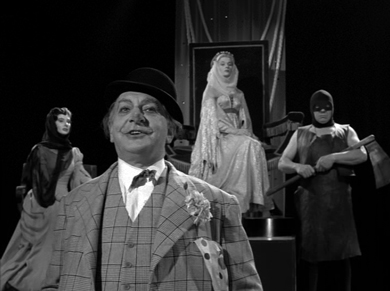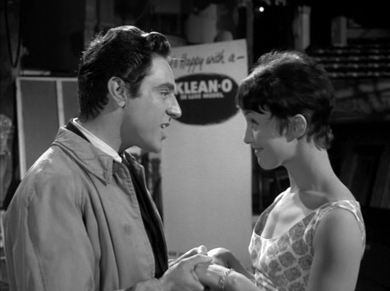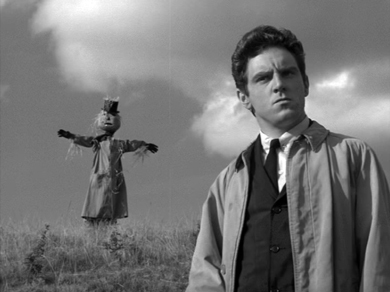
 |
|
|
|
Anthony Newley's turns as a film star (X the Unknown), pop star, songwriter (Willy Wonka and the Chocolate Factory) and variety performer remain well documented. Network DVD's new release of The Strange World of Gurney Slade - a surreal television series that was devised by Newley in 1960 - serves to add another string to the multi-talented star's bow. Newley can now also be thought of as the godfather of the more knowingly hip and esoteric strands of British cult television. Subversive and eccentric in equal measure, Gurney Slade undoubtedly paved the way for later Brit TV shows like The Avengers, The Prisoner, The Corridor People and Monty Python's Flying Circus. 
Appearing at the very start of the 1960s, Gurney Slade is irreverent and revolutionary at both a narrative and a formal level. Parts of the show come on like a televisual take on the kind of surreal madness previously found in The Goon Show's radio broadcasts. However, Gurney Slade is also distinguished by the fact that it effortlessly incorporates the kind of stylish and distinctly postmodern visual and thematic frills that are generally associated with Richard Lester's early films. Perhaps not surprisingly, the prime time television audience that Gurney Slade was initially unleashed upon remained baffled and nonplussed by the show's unconventional approach and the series finished its run tucked away in a late night slot, watched only by a faithful few. The show was simply too far ahead of its time. There is no actual credit for a director to be found in Gurney Slade's front or end titles. The IMDB suggests that producer Alan Tarrant directed the series but - given the strength of the personal stamp that Anthony Newley reportedly put on the show as a whole - it has been assumed by many that Newley himself directed Gurney Slade. Gurney Slade is just six episodes long and each episode runs to around 27 minutes. When originally broadcast on commercial television, each episode featured one break for advertisements and Network have left the show's stylish and cryptic break bumpers in place here. Given the completely original and groundbreaking nature of The Strange World of Gurney Slade's content, the following synopses of each episode do necessarily feature some mild spoilers.
The live broadcast of an inane television sitcom descends into chaos when its increasingly disillusioned lead actor, Gurney Slade (Anthony Newley), suddenly refuses to respond to his cues. Gurney walks off of the set and straight out of the studio. However, ever-present cameras follow Gurney and duly record his gradual withdrawal into his own strange world: a world where he is able to communicate with animals and inanimate objects and hear the thoughts of other people. Meaningful conversations with a dog, a rock and a dustbin ensue before Gurney enjoys a brief dalliance with a beautiful girl (Una Stubbs) who steps out of an advertisement for a vacuum cleaner.
Gurney laments that social rules and etiquette mean that he doesn't get to meet the kind of women that he really finds attractive. The pessimistic dreamer constructs an experiment that is designed to test the theory of "love at first sight" but declines to take advantage of his findings. When he accosts a married couple and their three children, Gurney's assertion that most people marry for convenience results in the couple re-assessing their relationship before taking off to find their perfect partners. Left to look after the abandoned kids, a chance meeting with a fairy leads to Gurney being granted a magic wish.
Gurney's travels have taken him deep into the British countryside, where he observes, passes comment on and interacts with a variety of animals. A wise old dog reveals that he runs a farm while offering interesting insights into the behaviour of his human pets, who are seen behaving bizarrely in the background. A scarecrow hums 'Greensleeves' (prompting Gurney to sing along) and a party loving cow (fantastically voiced by the wonderful Fenella Fielding of Carry On Screaming) puts a smile on Gurney's face. A chance encounter with Napoleon Bonaparte (John Bennett) reveals why the French emperor liked to pose with his right hand tucked into the front of his waistcoat.
Gurney finds himself standing trial in a courtroom: he's been charged with having no sense of humour and being responsible for the creation of an unfunny television show. A fairytale princess, Eleanor ("the one who never laughed"), is passing judgment and she's brought her executioner along. The prosecutor (Douglas Wilmer) projects a lengthy film of Gurney waxing lyrical about an advertisement for "countersunk screws" in order to prove his point. Gurney's defence councillor, a shambolic music hall comedian, is hopelessly out of his depth. With a jury made up of homogenous-looking, cloth-cap and white-scarf wearing men and star witnesses like a family who are said to be "a typical television audience", Gurney's fate appears to be sealed. 
Sat within the ruins of a miniature Greek amphitheatre, Gurney is telling a group of children a fairytale about a magic tinker when he's suddenly interrupted by two wandering wedding party guests, Albert (Bernie Winters) and Veronica (Coral Fairweather), and a less than magic tinker (Charles Lloyd Pack). When Gurney explains that anything can happen in Gurneyland, those gathered around him spontaneously transport themselves there. Since Gurneyland is inside Gurney's mind, he is forced to enter his own psyche in order to find a way to evict the visitors who are running riot there. Since nobody wants to leave the manic utopia that is Gurneyland, Gurney is forced to follow the cheeky course of action that is suggested by his "wicked side" incarnate.
Gurney is back on the soundstage of the television studio where we first met him. He's in a reflective mood, musing about how he was born there six weeks ago and accepting that, in less than twenty-two minutes, his adventures will come to an end. The actions of an unseen director and his attendant vision mixer - and a series of ominous knocks on the studio's door - serve to create an unsettling atmosphere. Gurney is waiting for somebody to come and collect him but complications arise when the characters that he dreamed up in earlier episodes suddenly appear and demand to know what fate awaits them. It's hard to know where to begin when describing this show's many innovations. The series is certainly striking in the way that it seeks to reveal the artifice of television (and, by extension, film): the behind-the-scenes segments of the first episode and much of the final episode serve to offer a real insight into how television shows are constructed. And Brechtian distanciation techniques (Gurney's lengthy interior monologues, Gurney directly addressing the camera and the audience, Gurney commenting on how many minutes of an episode are remaining and acknowledging bravura tracking shots, Gurney magically summoning up the show's great theme tune at the start of each episode by raising a hand and miming a series of piano key strikes, etc) are employed to great effect. The talking animals (which are similar to those seen in Johnny Morris's thoroughly fun Animal Magic show) and the talking inanimate objects (which surely had some influence on the surreal content of The Young Ones) provide an odd but effective twist too. The character Gurney is playing in the aborted sitcom is a bored and worn-down member of the white-collar working class and Gurney - a bored and worn down actor - seemingly stays in character when he walks off of the show's set. The suburban locations that he initially operates within are one of a number of elements that link Gurney to Billy Fisher from Billy Liar. Both men are frustrated young dreamers who deal with their feelings of boredom and day-to-day drudgery by retreating into fantasy worlds and creating their own subversive entertainment, like making up and using new words, etc. The strange words and phrases that Gurney makes up are reminiscent of Stanley Unwin's "Unwinese". At times Gurney comes on like the missing link between Charlie Chaplin's Little Tramp and Rowan Atkinson's Mr Bean. Gurney is seemingly seeking a sense of freedom but the only way to attain this is to step outside of the societal system and become a wandering tramp-like figure. Gurney flashes the same strained grimace-cum-smile as Chaplin's iconic character when he has run-ins with authority figures and, when he's up to something subversive or anti-social (like slyly purloining a newspaper from a news stand situated in a quiet park), he moves around in an exaggeratedly awkward manner akin to Mr. Bean. Just like Mr. Bean, Gurney spends most of episode five clinging onto a child's teddy bear. Gurney's search for a sense of freedom, his desire to express his individuality and his disdain for society's constraining rules all seemingly link Gurney Slade to The Prisoner. Gurney makes references to "Big Brother" and the ever-present cameras and eyes that are watching him. In some ways Gurney Slade plays like The Truman Show, the difference being that Gurney knows (or at least thinks that he knows) what's going on around him. When Gurney travels to "Wonderland" with the girl from the vacuum cleaner ad, constraining societal rules and regulations are temporarily reversed: a sign reads "Please keep on the grass", etc. It is tempting to suggest that Gurney Slade's influence can be felt in the episode of The Prisoner -- The Girl Who Was Death -- that features a Napoleon figure, Napoleonic imagery and Number Six acting as a children's storyteller. Similarly, the various scenarios involving brainwashing and drug-induced psychic fantasies found in The Prisoner chime with the journey into Gurney's psyche and the appearance of his "wicked side" incarnate and other doppelgangers. And both shows feature a bizarre Kafka-esque trial. Interestingly, Anthony Newley made an eccentric version of 'Pop Goes the Weasel' one of his signature tunes in the UK and a variant of the same nursery rhyme-cum-song appears throughout The Prisoner. 
But Gurney Slade's content also appears to be concerned with the idea that some serious showbiz artists are mindful of quality and content when choosing which shows they appear in. Added to this is perhaps the notion that sensitive artists need to escape from the pressures and attention that their fame brings. The show also features early comments about the paparazzi's approach to selling celebrity-oriented stories, etc. One tabloid hack reveals that his paper prepared their account of Gurney's trial before judgment had been passed and when Gurney refuses to reveal his life story the hack simply elects to use a potted history supplied by a glamour model who claims to have known Gurney. Gurney's initial decision to go AWOL from the television studio and his subsequent activities play very similarly to Ringo Starr's unscheduled disappearing act in Richard Lester's A Hard Day's Night. Both characters come under the suspicious gaze of policemen on the beat as they listlessly gravitate towards local parks and riverbanks. Stylistically and thematically, parts of Gurney Slade are as inspired as the inventive set pieces found in Lester's Help and The Knack. There are some really noticeably long takes in evidence at times - as well as a number of really extreme long shots - and the show's camera angles and camera movements are all employed in a stylish and completely assured way. Gurney Slade's director and art directors consistently serve up a postmodernist bricolage of striking styles and themes. Gurney's dalliance with the girl from the vacuum cleaner ad is shot in the style of a silent movie, Gurney's court room escapade draws upon fairy tale imagery, the bizarre activities of the farmer, his wife and their hired hand in episode three bring to mind a Russ Meyer film or a German Alpine sex comedy, the journey into Gurney's psyche fuses science fiction imagery with British music hall entertainment, the dismembered mannequins that litter the desolate landscape that the fairy transports Gurney to bring to mind Alice Cooper's stage show, etc. The series also sports a determinedly absurdist streak: Gurney and the girl from the vacuum cleaner ad treating her attendant vacuum cleaner like it's a child, the jury of homogenous looking men, the talking animals and inanimate objects, Gurney's self-invented words, etc. There's plenty of well-observed satire here too: the only figures that concern a millionaire businessman who has been employed to save Britain from impending financial ruin are the vital statistics and the telephone numbers of the beautiful girls that his money and status grant him access to. And the show features a variety of comments that are concerned with the consumer society, etc. Throw in a multitude of bizarre enigmas, a winning performance by Newley (he even sings a couple of songs) and impressive turns by a number of cult personalities (music hall/variety stalwart Bernie Winters, Annika (Anneke) Wills of Doctor Who, James Villiers of Blood from the Mummy's Tomb and These are the Damned, Una Stubbs of Till Death Us Do Part and Worzel Gummidge, et al) and the show's appeal for cult text status is more than assured. 
From The Prisoner to Twin Peaks and beyond, we now accept that any cult TV show worth its salt will come saddled with a finale that prompts more questions than it answers. Once again, Gurney Slade appears to have written the rulebook. The startlingly surreal and macabre nature of the show's final scene results in an unsettling and downbeat conclusion for Gurney's adventures: a final satirical comment about the true nature of celebrity, a damning symbolic representation of how little autonomy and control ordinary people really have over their lives or simply a magical end to a magical series? You'll have to answer that one yourselves. Network only supplied a DVD-R of this release for review purposes. But if the factory pressed discs are of the same quality as the DVD-R, viewers will have little to complain about: picture and sound quality here are both excellent. The Strange World of Gurney Slade was shot entirely on film and it has been transferred to DVD(-R) in a wholly pleasing way. The show's crisp black and white cinematography looks great. The presentation's sound quality is near enough excellent too. The disc's extra features include six television spots for the show. They're all inventive, knowing and entertaining and they indicate that Newley and his collaborators were fully aware that they were unleashing a completely new kind of television show upon the unsuspecting British public. Note: Network DVD suffered warehouse stock damage during the recent disturbances in London. Consequently, copies of Gurney Slade appear to be in short supply at the moment. However, Network advises that replacement stock of this title and others will be shipping to retailers very soon.
On a scale of Excellent, Good, Fair, and Poor,
Reviews on the Savant main site have additional credits information and are often updated and annotated with reader input and graphics. Also, don't forget the 2011 Savant Wish List. T'was Ever Thus.
Review Staff | About DVD Talk | Newsletter Subscribe | Join DVD Talk Forum |
| ||||||||||||||||||